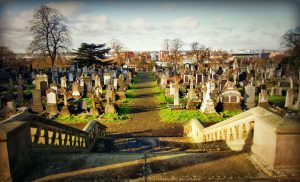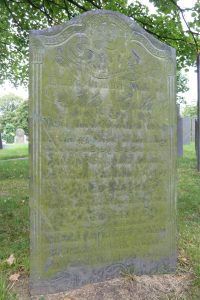 (photo: Friends of Welford Road Cemetery)
(photo: Friends of Welford Road Cemetery)
Welford Road Cemetery in Leicester plays a pivotal role in my family history; at the last count, more than 80 members of my extended family have been buried here. Since the cemetery opened in 1849, my relatives will no doubt have visited many times. And one rather dramatically ended his life at the cemetery. Through a series of blog posts let me take you on a walk about, stopping off at some family graves and tuning in to the history of the cemetery as we progress.
Let’s begin at the main gates on Welford Road. As you head along the driveway, the traffic noise subsides and you’re soon surrounded by greenery, birdsong and impressive monuments. Like many early Victorian cemeteries, the landscaping of Welford Road Cemetery was inspired by the ‘garden cemetery’ movement which espoused that burial grounds should be designed not only for the dignified repose of the dead but also for the pleasure of the living. Visiting your dearly-departed on a Sunday afternoon, they argued, should also bring with it the chance to enjoy a beautiful setting.
To the right of the main entrance the visitors’ centre – opened in 2006 as a base for the Friends of Welford Road Cemetery – is a good starting point for those keen to track down their ancestors buried in the cemetery.
But today, on this walk, we nip immediately behind the centre. Tucked round the back, on a sloping embankment, there are serried ranks of slate headstones. At first glance, it’s an odd place for graves to be positioned, with lawn falling away so steeply. A closer look at the inscriptions also indicates something is amiss – virtually all of the years mentioned on the stones pre-date the 1849 opening of the cemetery. How can this be?
These are the so-called Cathedral Gravestones, moved here in 2014 from the churchyard of Leicester Cathedral, previously St Martin’s parish church in the centre of Leicester. As the Friends’ website explains: “In 2014 work was carried out by Leicester City Council on Leicester Cathedral. The work was part of an expensive £2.5 million scheme to transform the grounds that surround the Cathedral… at the same time as the new £4 million Richard III visitor centre was being built. The renovation included new lawns, trees, flower beds, sculptures, a water feature and an outdoor arena for staging events. None of the burial plots at the Cathedral were disturbed. However in order for work to take place they had to remove approx. 120 headstones located in the Cathedrals grounds. Sixty seven of these have now been permanently re-located to the Welford Road Cemetery, just behind the Visitors centre. The remainder either form part of the landscaping at the Cathedral or are located at Saffron Hill Cemetery.”
Among these re-located headstones now at Welford Road, look out for Elizabeth Collis, two of her infant children and her brother-in-law, George. You’ll find them on the third row back, sixth headstone from the left, framed either side by columns inscribed into the edges of the slate.
“Sacred to the memory of Elizabeth wife of John Collis who died March 6th 1814 in the 44th year of her age. Also of their children Maria died May 1st 1798 aged 4 years. George died April 28th 1804 aged 1 year. Likewise of George Collis brother to John Collis. He died March 28th 1802 Aged 22.”
I remember spotting this headstone many moons ago when it was at St Martin’s churchyard and became alarmed when I later re-visited to find it gone. After a flurry of emails I was relieved to track it down to its new location at Welford Road Cemetery.
It’s our oldest surviving family headstone in Leicester – thanks in large part to the choice of Swithland slate as the material – and the crisp lettering and elegant flourishes are still as legible as the day the stonemason inscribed them. “Swithland slate is ideal for fine carving and is very durable, so it is still possible to see some headstone carvings in almost their original condition. It is estimated that there are over 10,000 slate headstones in Leicestershire (Airey, 2009) and a good rule of thumb for identifying Swithland slate is that the reverse side is rough. The grey, blue and purple tinges of the slate add huge visual appeal to the region’s churchyards, while the content of the carving – like headstones across the world – tell us something of the people and cultures that created them.” writes the team at East Midlands Oral History Archive (Leicester University).
Elizabeth Collis was born c1770 in Thurmaston, the daughter of blacksmith Edward Watts and Sarah (nee Palmer). She married John Collis in 1793 and it was thanks to Elizabeth’s uncle, William Watts, that patternmaker John was able to secure employment at Cort & Co’s foundry where Watts was a partner. The Watts family connection gave John Collis a certain security, status and a modest but reliable income. Enough to commission this rather beautiful Swithland slate headstone when his wife died in 1814.
Following Elizabeth’s death, John Collis re-married – to Matilda Russell, nee Harrison (from which marriage we are descended) – and all was well until a crisis struck the family in 1823. John was accused of stealing patternmaking tools from Cort’s foundry, found guilty and imprisoned in Leicester Bridewell. You can read the full story here in my Trading Stories, Working Lives series: the trial of John Collis, engineer’s patternmaker.
Stepping back from the headstone, I take stock. Despite having been moved about a mile down the road from its original location, and notwithstanding John Collis’ criminal episode, I still experience a flush of pride at seeing the Collis name inscribed so elegantly into the purple-grey Swithland slate. One way or another, this headstone has stood for over 200 years. Let’s hope it’s still standing and legible for many more years to come.
From here, retrace your steps back to the visitors’ centre and head further along the main driveway into the cemetery for our next Grave Encounter…



